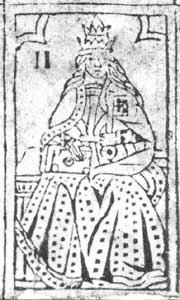The High Priestess
This article includes a list of general references, but it lacks sufficient corresponding inline citations. (May 2024) |

The High Priestess (II) is the second
In the creation of the Rider–Waite Tarot deck, the Popess of the playing card packs was changed into The High Priestess of cartomantic cards. She wears a crown similar to the one used by the goddess Hathor, and is depicted with Marian imagery. A. E. Waite, the co-creator of the Rider–Waite deck, speculated that the card was connected to the ancient cult of Astarte or Mary as a representation of the Mother goddess.[1]
History

La Papesse
This Tarot card was originally called La Papesse, or "The Popess". Some of the cards directly linked the woman on the cards to the papacy by showing the woman wearing a triregnum or
Other variants
In the Rider–Waite Tarot, illustrated by Pamela Coleman Smith, the Popess was changed into The High Priestess sitting between the pillars of Boaz and Jachin (which has a particular meaning to Freemasonry). She wears a crown similar to the Egyptian goddess Hathor and is depicted with the Marian imagery of a blue mantle and the moon at her feet. A. E. Waite, the co-creator of the Rider–Waite deck, dismissed the idea that the card originally depicted Pope Joan and speculated that it was instead connected to the ancient cult of Astarte.[1]
Other variants that came after Rider–Waite are the
Sister Manfreda

La Papessa in the Visconti-Sforza Tarot has been identified as a depiction of Sister Manfreda, an Umiliata nun and a relative of the Visconti family who was elected Pope by the heretical Guglielmite sect of Lombardy. In The Tarot Cards Painted by Bonifacio Bembo, Gertrude Moakley writes:
Their leader, Guglielma of Bohemia, had died in Milan in 1281. The most enthusiastic of her followers believed that she was the incarnation of the Holy Spirit, sent to inaugurate the new age of the Spirit prophesied by Joachim of Flora. They believed that Guglielma would return to earth on the Feast of Pentecost in the year 1300, and that the male dominated Papacy would then pass away, yielding to a line of female Popes. In preparation for this event they elected Sister Manfreda the first of the Popesses, and several wealthy families of Lombardy provided at great cost the sacred vessels they expected her to use when she said Mass in Rome at the Church of Santa Maria Maggiore. Naturally, the Inquisition exterminated this new sect, and the "Popess" was burned at the stake in the autumn of 1300. Later the Inquisition proceeded against Matteo Visconti, the first Duke of Milan [sic], for his very slight connections with the sect.[5]
This identification has been supported by other Tarot historians, such as Michael Dummett in his book The Visconti-Sforza Tarot Cards.[citation needed]
Symbolism
Rider–Waite symbolism
In the Rider–Waite–Smith tarot, the basis for many modern tarot decks, The High Priestess is identified with the
The motif that hangs behind the High Priestess’s throne, veiling whatever mysteries she guards, is suggested in the pattern of
Tarot of Marseilles symbolism
In the
Interpretation
The modern interpretation of the High Priestess represents the unknown, mystery, intuition, spiritual knowledge, and the subconscious mind. She is an esoteric figure, unlike The Hierophant. Reversed, the High Priestess can be interpreted as secrecy and disconnection from your intuition.[citation needed]
According to A. E. Waite's 1910 book The Pictorial Key to the Tarot, the High Priestess card is associated with:
Secrets, mystery, the future as yet unrevealed; the woman who interests the Querent, if male; the Querent herself, if female; silence, tenacity; mystery, wisdom, science. Reversed: Passion, moral or physical ardor, conceit, surface knowledge.[9]
In astrology, the High Priestess's primary correspondence is to the Moon.[3] On the Tree of Life, she is on the path leading from Kether to Tiphareth.[10]
References
- ^ a b Waite (1926).
- ^ Dean 2018, p. 65.
- ^ a b Crowley (1991), p. 24.
- ^ Rustici (2006), pp. 1–2.
- ^ Moakley (1966), p. [page needed].
- ^ Waite (1979), pp. 13, 79.
- ^ Waite (1979), p. 76.
- ^ Sharman-Burke (1985), pp. 35–36.
- ^ Waite (1979), p. 283.
- ^ Crowley (1991), p. 266.
Works cited
- ISBN 978-0-87728-268-6.
- Dean, Liz (2018). The Ultimate Guide to Tarot. Fair Winds Press.
- Moakley, Gertrude (1966). The Tarot Cards Painted by Bonifacio Bembo for the Visconti-Sforza Family: An Iconographic and Historical Study. The New York Public Library. .
- Rustici, Craig M. (2006). The Afterlife of Pope Joan: Deploying the Popess Legend in Early Modern England. University of Michigan Press. ISBN 978-0-472-11544-0.
- Sharman-Burke, Juliet (1985). The Complete Book of Tarot. London: Pan. OCLC 1029289960.
- Waite, Arthur Edward (February 1926). "The Great Symbols of the Tarot". The Occult Review. 43 (2): 85–86.
- Waite, A. E. (1979) [1910]. The Pictorial Key to the Tarot. New York: ISBN 0-87728-218-8.
- Attribution
- This article incorporates text from the Arthur Edward Waite. Please feel free to update the text.
Further reading
- Boureau, Alain (2001). The Myth of Pope Joan. Chicago: University of Chicago Press. ISBN 978-0-226-06745-2.
- Stanford, Peter (1999). The Legend of Pope Joan: In Search of the Truth. Henry Holt and Company. ISBN 978-0-8050-3910-8.
- Venn-Lever, Barbara (2007). Tarot for the Curious Spirit: Awakening the High Priestess Within. John Hunt Publishing. ISBN 978-1-84694-003-3.
External links
 Media related to Popess (Major Arcana) at Wikimedia Commons
Media related to Popess (Major Arcana) at Wikimedia Commons
